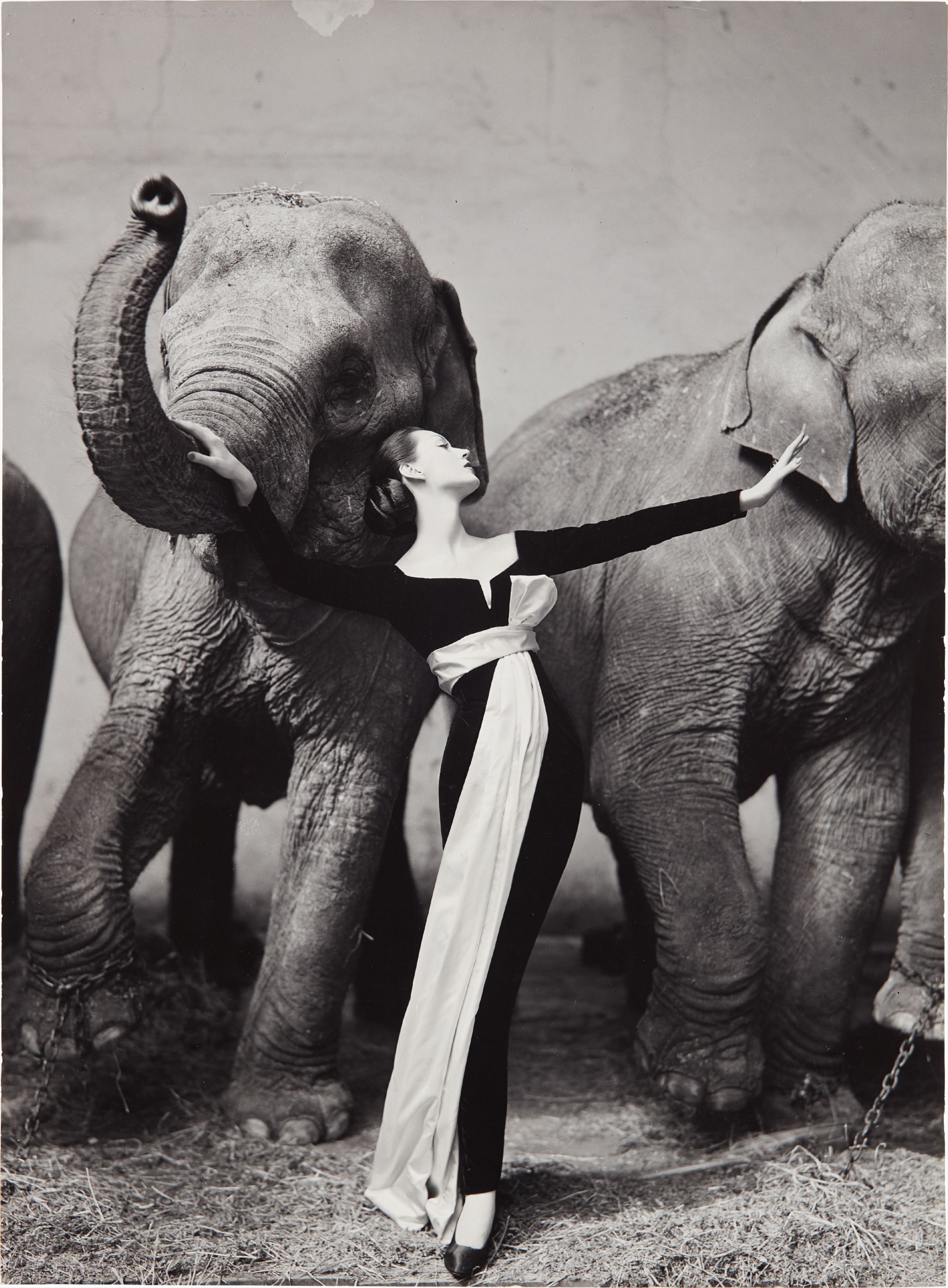

29
Richard Avedon
Dovima with Elephants, Evening dress by Dior, Cirque d’Hiver, Paris, August
Full-Cataloguing
The Smithsonian Institution in Washington, D.C. took an interest in the School, putting on a series of solo exhibitions for the ten faculty photographers, starting with Richard Avedon in 1962. For this – his first major museum retrospective – the curators tacked many of the prints directly to the gallery wall, juxtaposing his portraiture against his fashion work, which included a print of Dovima with Elephants, 1955.
In February 1964, the FPS ran an advertisement in LIFE magazine that stated, ‘Now – no matter where you live – you can “apprentice” yourself to the most successful photographers of our time.’ It continued, ‘Ten of the world’s greatest photographers have joined together to create a professional-level course in photography to help you develop your skill, judgment, and craftsmanship … and to pass on to you their secrets for achieving success and recognition.’ A total of 24 lessons were assembled in four hardbound volumes and sold as subscriptions.
The FPS presented Avedon as the ‘world’s highest paid fashion photographer’ and showcased Dovima with Elephants as his signature fashion image. In ‘Lesson One’, on page 10, a full-page reproduction of the work was accompanied by Alfred Eisenstaedt’s fulsome description of Avedon and this photograph:
The purpose of this picture – an illustration for a fashion magazine – was to make people stop and look at the gown the model is wearing. Richard Avedon achieved his goal with characteristic wit
and imagination.
Like many of Avedon’s photographs, this one began with a visual idea: to pose a beautiful model wearing the gown in front of a grotesque background of circus elephants. This startling combination of beauty and the beasts would have the attention getting effect he wanted. Of course, the fantastic situation, appropriate for the high-fashion publication he was shooting for, was not intended to be taken literally.
In the hands of a less skilled photographer, the same idea might have turned out as merely a gag shot. But Avedon added the element of his own highly creative personal seeing. He saw the elephants not just as huge, ungainly beasts, but also as shapes with graceful curves that repeat the curves of the model and her gown. He used both sets of curves, combining them in one picture. When we look at the photograph we are struck by the incongruous situation but also pleased by the way the similar curves are woven into a satisfying design.
In 1974, the FPS filed for bankruptcy and for nearly 40 years, their archives lay virtually untouched and forgotten. In 2011, the FPS Archive was founded and in 2016, it was acquired by the Yale University Art Gallery. They are currently cataloguing the School’s collection: the photographic prints, contact sheets, negatives, printed material, lesson plans, audio files and miscellaneous paperwork.
In 1964, the same year that the lessons were assembled and sold, the FPS produced a prospectus, featuring individual shots of the faculty photographers on the front and back covers (fg. 1). A small reproduction of Avedon’s Dovima with Elephants, alongside nine other images by the other faculty members, appears on page 9, opposite some promotional text on page 8. The present lot offered here is annotated ‘p. 8-9’ in an unidentified hand on the mount verso; this numbering may be related to the prospectus reproduction.
The present lot also shows a small area of paler tone at the top edge of the image. This indicates that the print was made from the original 8 x 10 in. negative, which resides in the Richard Avedon Foundation. 20 years after the photograph was taken, in the mid-1970s, Avedon started creating editioned prints to sell in the budding photography market. For Dovima with Elephants, the paler-toned area was omitted in the editioned prints. It is likely that these were printed from a copy negative made from a retouched master print.
This rare, early print of Dovima with Elephants – Avedon’s most iconic fashion photograph – presents collectors with a unique glimpse into his work as a teacher and his participation with the FPS.
Richard Avedon
American | B. 1923 D. 2004From the inception of Richard Avedon's career, first at Harper's Bazaar and later at Vogue, Avedon challenged the norms for editorial photography. His fashion work gained recognition for its seemingly effortless and bursting energy, while his portraits were celebrated for their succinct eloquence. "I am always stimulated by people," Avedon has said, "almost never by ideas."
Indeed, as seen in his portraits — whether of famed movie stars or everyday people — the challenge for Avedon was conveying the essence of his subjects. His iconic images were usually taken on an 8 x 10 inch camera in his studio with a plain white background and strobe lighting, creating his signature minimalist style. Avedon viewed the making and production of photographs as a performance similar to literature and drama, creating portraits that are simultaneously intensely clear, yet deeply mysterious.